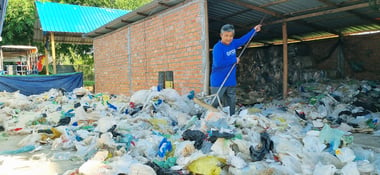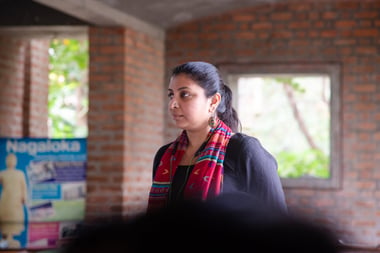
Beth Howell
Beth has been writing about the environment and climate change for over four years now – with her work being featured in publications such as The BBC, Forbes, The Express, Greenpeace, and in multiple academic journals.
Sarah-Jeanne Royer is an oceanographer and post-doctoral researcher at Scripps Institution of Oceanography, based in California.
Specializing in plastic and microfibre degradation in the environment, Sarah has an abundance of knowledge that we at CleanHub find invaluable.
When working with researchers at the University of Hawaii in 2015, she discovered that plastic debris in the ocean is a considerable source of methane and other greenhouse gas emissions.
In her research, Royer works towards a better understanding of this process, whilst convincing leaders and policymakers to develop better laws to reduce the production and consumption of plastic.
Our very own Joel Tasche was happy to chat with her about her research.

Q. Could you tell us more about your findings on plastic waste emitting greenhouse gases?
A: Yes, this was actually an unexpected discovery!
My colleagues set out to measure methane gas production from biological activity in the ocean. While they were collecting and incubating sea water, they measured methane concentrations which were much higher than expected.
They realized that the methane emissions were coming from the plastic bottles in which they were incubating seawater. The bottles were a much bigger source of the gas than the biology itself.
I found this very interesting and decided to concentrate my research on this area.
Q. What causes plastic to emit these gases?
A: So, plastic emits methane and other types of greenhouse gases, such as ethylene, ethane, and propylene as it photodegrades.
These hydrocarbons get synthesized during the reorganization of the chemical molecules — mostly due to the effect of oxidation. These gases are only a small fraction of what gets emitted from plastics.
However, we could not measure the variety of gases produced due to instrumental limitations.
We also measured carbon dioxide and carbon monoxide. Most of the gases we measured have a negative effect on the environment and an effect on climate change.
We tested this for the seven most commonly used types of plastics and found that LDPE, which stands for low-density polyethylene, emits the most gases. Unfortunately, this is also the most commonly produced and discarded type of plastic in the environment.
That includes plastic bags, candy wrappers — the so-called multi-layer packaging — and other types of single-use plastics.
I decided to focus on LDPE only and then made another alarming discovery: When plastic degrades the surface area increases and more and more gases are released.
Once exposed to UV light, the off-gassing never stops. We compared LDPE powder to LDPE pellets, and found that the powder produced 488 times more methane than the pellets. This means that as the plastic degrades and fragments in the environment the production of greenhouse gases can only increase.
This is bad news.
Q. Does this only happen when sunlight and water are involved? What about the plastic waste on land and in landfills?
A. As an oceanographer, obviously I’m interested in looking at plastics submerged in water — but we decided to lead an experiment where we compared our initial research to plastic exposed to air and on land.
We discovered that plastic in the air produces three times more methane and 76 times more ethylene and other greenhouse gases than when submerged in water.
When we talk about plastic pollution as a global issue, we often refer to the ocean. But in terms of greenhouse gas emissions, it is actually also a huge problem for terrestrial environments.
Think about all the types of plastic you find in the street, in your backyard, in the swimming pool, as well as in landfills. All of them continuously emit greenhouse gases once they have been hit by UV light. And they continue to emit gases, even if you would take that plastic into your house or store it in the dark.
Q. How bad are emissions from a piece of plastic compared to other items?
A. Good question. We tried to find estimates for all the plastic floating at the surface of the ocean and compare its greenhouse gas production to that of biological waste on land. We found that their emissions were quite similar.
But then, we don’t have accurate numbers about the quantity of plastic currently exposed to air as we mostly look at the ocean.
Q. How do we solve this dilemma?
A: Well, of course, we all know the best solution would be to stop using plastic altogether — but for now, this is unrealistic.
I feel strongly about reusing plastic, but we have to be smart about it. For instance, the textile industry is turning PET plastic bottles into polyester, but when we wash these clothes synthetic microfibers will go back into the environment.
Then there are projects in the field of construction that “hide” big chunks of plastic in housing structures and in road construction. These solutions are not perfect yet and still at a small scale — but they are better.
Q: What are your thoughts on incinerating non-recyclable waste?
A: I think it’s going to be more expensive, but it is better than landfilling it openly. We have to pay the price, otherwise the planet will suffer.
I think there are many different ideas and projects — and yours is one of them. I would love to hear back about how it is going.
Summary
We'd like to thank Sarah-Jeanne Royer for taking the time to talk to us about her research and the importance of moving away from single-use plastics.
Without research on this important topic, we won't be able to effectively deal with the plastic pollution crisis.
Want to continue learning about plastic waste? Check out some of our similar articles below:

.webp)



.jpg?width=380&name=drone-2021-12-06-10h31m38s177%20(1).jpg)




-2.png?width=380&name=Untitled%20design%20(2)-2.png)
-1.webp?width=380&name=microplastics%20(1)-1.webp)
